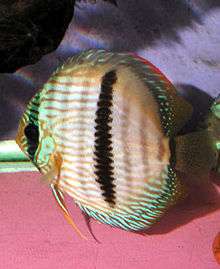Discus (fish)
| Symphysodon | |
|---|---|
 | |
| Symphysodon aequifasciatus | |
| Scientific classification | |
| Kingdom: | Animalia |
| Phylum: | Chordata |
| Class: | Actinopterygii |
| Order: | Perciformes |
| Family: | Cichlidae |
| Subfamily: | Cichlasomatinae |
| Tribe: | Heroini |
| Genus: | Symphysodon Heckel, 1840 |
| Type species | |
| Symphysodon discus Heckel, 1840 | |
| Species | |
|
See text | |
Symphysodon, colloquially known as discus, is a genus of cichlids native to the Amazon river basin. Due to their distinctive shape and bright colors, discus are popular as freshwater aquarium fish, and their aquaculture in several countries in Asia is a major industry.[1][2][3][4] They are sometimes referred to as pompadour fish.[5][6]
Species
There are currently three recognized species in this genus that are found in nature:[7]
- Symphysodon aequifasciatus Pellegrin, 1904 (Blue discus)
- Symphysodon discus Heckel, 1840 (Red discus or Heckel discus)
- Symphysodon tarzoo E. Lyons, 1959
Taxonomy

Discus are fish from the genus Symphysodon, which currently includes the above species.[8] However, another review of the genus published in August 2007 suggested that the genus held these three species: S. aequifasciatus (the green discus), S. haraldi (the blue/brown/common discus), and S. discus (the Heckel discus).[9] Further arguments have been made that S. tarzoo was not described in accordance with ICZN rules and thus should be considered invalid and replaced with S. haraldi,[10] currently considered a synonym of S. aequifasciatus by FishBase.

Other (sub)species have been proposed, but morphometric data (unlike in Pterophyllum, the freshwater angelfish) varies as much between individuals from one location as across the whole range of all discus fish species. S. tarzoo was described in 1959 and applies to the red-spotted western population. S. aequifasciatus and S. discus, meanwhile, seem to hybridise frequently in the wild or have diverged recently, as they lack mitochondrial DNA lineage sorting but differ in color pattern and have dissimilar chromosomal translocation patterns. S. discus occurs mainly in the Rio Negro. Whether S. haraldi is indeed distinct from S. aequifasciatus remains to be determined; if valid it is widespread but it might just be a color morph.
Description
Like cichlids from the genus Pterophyllum, all Symphysodon species have a laterally compressed body shape. In contrast to Pterophyllum, however, extended finnage is absent giving Symphysodon a more rounded shape. It is this body shape from which their common name, "discus", is derived. The sides of the fish are frequently patterned in shades of green, red, brown, and blue. The height and length of the grown fish are both about 20–25 cm (8–10 in).
Reproduction and sexual dimorphism

There is no real sexual dimorphism for this fish. In breeding form varieties, solid red discus (red melon, red cover) females are generally redder than males. Another characteristic of Symphysodon species is their care for the larvae. As for most cichlids, brood care is highly developed with both the parents caring for the young. Additionally, adult discus produce a secretion through their skin, which the larvae live off during their first few days. This behaviour has also been observed for Uaru species.[11]
Distribution and habitat

Symphysodon species inhabit the margins of floodplain lakes and rivers in the Amazon Basin of lowland Amazonia,[12] where it is part of the highly diverse Neotropical fish fauna.
The three species of Symphysodon have different geographic distributions. S. aequifasciatus occurs in the Rio Solimões, Rio Amazonas and the Río Putumayo-Içá in Brazil, Colombia and Peru. In contrast the distribution of S. discus appears to be limited to the lower reaches of the Abacaxis, Rio Negro and Trombetas rivers. S. tarzoo occurs upstream of Manaus in the western Amazon.
See also
References
- ↑ Loiselle, Paul V. (1995). The Cichlid Aquarium. Germany: Tetra Press. ISBN 1-56465-146-0.
- ↑ Sands D (1994) A fishkeepers guide to Central American cichlids. Tetra Press. Belgium pg 59-60.
- ↑ Mills D (1993) Aquarium Fish Harper Collins ISBN 0-7322-5012-9
- ↑ Chong, K.; Ying, T. S.; Foo, J.; Jin, L. J.; Chong, A. (2005-09-12). "Characterisation of proteins in epidermal mucus of discus fish (Symphysodon spp.) during parental phase". Aquaculture. 249: 469–476. doi:10.1016/j.aquaculture.2005.02.045.
- ↑ Discus fish - Page 5 Thomas A. Giovanetti, Matthew M. Vriends - 1991 "It was not until the 1930s and 1940s that aquarium-fish dealers began importing discus into Europe and the United States under the common name "pompadour fish." Discus are cichlids, which often surprises many aquarists."
- ↑ International Wildlife Encyclopedia Set - Page 2006 Robert Burton, Maurice Burton, 2002 "Popular aquarium fish because of their bright colors and attractive patterns, pompadour fish are actually quite difficult to keep and require frequent water changes. Pictured are a group of red discus, one of the two species of pompadour fish."
- ↑ Froese, Rainer, and Daniel Pauly, eds. (2013). Species of Symphysodon in FishBase. April 2013 version.
- ↑ "New Discus named Symphysodon tarzoo". Matt Clarke. practical fishkeeping. 2006-11-28. Archived from the original on March 7, 2009. Retrieved 15 August 2009.
- ↑ "Discus genus revised". Matt Clarke. Practical Fishkeeping. 2007-08-08. Retrieved 15 August 2009.
- ↑ Geerts, M. (2011): On the name Symphysodon Discus Tarzoo. The Cichlid Room Companion
- ↑ Buckley, J.; Maunder, R. J.; Foey, A.; Pearce, J.; Val, A. L.; Sloman, K. A. (2010). "Biparental mucus feeding: a unique example of parental care in an Amazonian cichlid". J. Exp. Biol. 213: 3787–3795. doi:10.1242/jeb.042929.
- ↑ Crampton (2008). "Ecology and life history of an Amazon floodplain cichlid: the discus fish Symphysodon (Perciformes: Cichlidae)". Neotrop. ichthyol. 6 (4): 599–612. doi:10.1590/S1679-62252008000400007.
External links
| Wikimedia Commons has media related to Symphysodon. |
| Wikispecies has information related to: Symphysodon |
- Basic Care Tips for Discus Fish
- Discus photogallery from Club Live World
- Discus Society Malaysia
- DXK Forum - Malaysia Premier Discus Forum
- IDF Discus - Photo albums of discus fish
- Fanatik-Discus-International informations, pictures, videos about discus fish
- Discus - Keeping
- Setting Up a Fish Tank for Discus